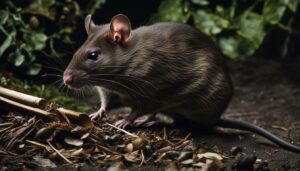Have you ever wondered if squirrels chew wood at night? In this article, we will uncover the truth and shed light on the nocturnal habits of these furry creatures.
Key Takeaways:
- Squirrels are nocturnal creatures and do chew wood at night.
- They chew on wood to wear down their teeth, find food, or create nesting sites.
- Chewing on wood can cause damage to homes and furniture.
- To prevent squirrels from chewing on wood, trim tree branches, seal openings in your home, keep your yard clean, and use taste deterrents.
- Take action if you suspect squirrels are causing damage to prevent further property damage.
Understanding Squirrel Behavior Patterns
To understand why squirrels chew wood at night, it’s important to delve into their behavior patterns and explore their nocturnal habits. Squirrels are fascinating creatures known for their busy and resourceful nature. They are diurnal, meaning they are primarily active during the day. However, some species of squirrels, such as the gray squirrel, exhibit nocturnal behavior, becoming more active and foraging at night.
During the day, squirrels engage in activities like gathering food, building nests, and socializing. However, when darkness falls, nocturnal squirrels take on a different routine. They venture out to explore their surroundings, searching for additional food sources and securing their nests. This shift in behavior is driven by various factors, including competition for resources, predation risk, and favorable environmental conditions.
Nocturnal Squirrel Habits
At night, squirrels showcase their agility and adaptability, utilizing their keen senses to navigate in low-light conditions. They rely on their excellent vision, hearing, and sense of touch to locate food and potential nesting sites. Their nocturnal activities also encompass territorial defense, communication through vocalizations and scent marking, and engaging in mating behaviors.
While squirrels may be active at night, their wood-chewing behavior remains consistent. Chewing on wood serves multiple purposes for squirrels, including dental hygiene and maintenance. Their teeth, which continually grow, can become too long if not properly worn down. Gnawing on wood helps keep their teeth at an appropriate length. Additionally, squirrels use wood as a way to find hidden insect larvae and nuts, which they store for future consumption.
| Squirrel Behavior Patterns: | Nocturnal Squirrel Habits: |
|---|---|
| – Busy and resourceful | – Foraging for additional food sources at night |
| – Primarily active during the day | – Navigating in low-light conditions with keen senses |
| – Gather food, build nests, socialize during the day | – Engage in territorial defense and mating behaviors at night |
| – Gray squirrel exhibits nocturnal behavior | – Use wood to maintain dental hygiene and find hidden food |
Understanding squirrel behavior patterns, especially their nocturnal habits, allows us to comprehend why they chew wood at night. By appreciating their need for dental care, food procurement, and shelter, we can take proactive measures to protect our wood structures and minimize potential damage caused by these furry creatures.
The Reasons Behind Nocturnal Wood-Chewing
Squirrels have fascinating reasons for their nighttime wood-chewing behavior, including dental maintenance, food search, and the creation of cozy nesting sites. This behavior is driven by their natural instincts and plays a crucial role in their survival.
One of the primary reasons why squirrels chew on wood is to wear down their teeth. Squirrels’ teeth grow continuously throughout their lives, and chewing on hard materials such as wood helps keep their teeth in proper length and shape. By gnawing on wood, squirrels prevent their teeth from becoming overgrown and causing potential health issues.
Another reason squirrels engage in wood-chewing is to search for food. Squirrels have a diverse diet that includes nuts, seeds, fruits, and even tree bark. Chewing on wood allows them to access hidden food sources and extract nutrients. They also gnaw on tree branches to reach stored food supplies, like acorns, which they can later consume.
Lastly, squirrels chew on wood to create cozy nesting sites. By gnawing on tree trunks, they can carve out cavities where they can build their nests. These nests provide shelter and protection for squirrels and their young, especially during harsh weather conditions.
| Reasons Behind Nocturnal Wood-Chewing: | Examples |
|---|---|
| Dental maintenance | Wearing down teeth to prevent overgrowth |
| Food search | Finding hidden food sources and accessing stored supplies |
| Creation of cozy nesting sites | Carving out cavities in wood for shelter and protection |
It’s important to understand the reasons behind squirrels’ wood-chewing behavior to effectively address and prevent any potential damage they may cause. By implementing measures to protect wood structures, such as trimming tree branches, sealing openings in your home, keeping your yard clean, and using taste deterrents, you can deter squirrels from chewing on wood and minimize the risk of damage to your property.
Remember, taking action is crucial if you suspect squirrels are causing damage. By being proactive and implementing preventive measures, you can protect your property and maintain a harmonious coexistence with these fascinating creatures.
Understanding the Damage Squirrels Can Cause
Squirrels may be small, but their wood-chewing habits can wreak havoc on trees, homes, and furniture if left unchecked. These furry creatures have a natural tendency to chew on wood, and when they do, it can result in significant damage. If you’ve ever wondered why your furniture has random gnaw marks or noticed chewed tree branches, squirrels are often the culprits.
When squirrels chew on wood, they are not only seeking to wear down their continually growing teeth, but they are also searching for food and creating nesting sites. This behavior can cause severe damage to trees, weakening their structure and potentially leading to their demise. In homes, squirrels can chew through electrical wiring, insulation, and even wooden beams, which can pose safety hazards and require expensive repairs. Additionally, their penchant for chewing can result in unsightly damage to furniture, leaving behind frustrating marks and holes.
To prevent squirrels from chewing on wood and causing further damage, there are several steps you can take. Firstly, consider trimming tree branches that are close to your home or other wooden structures. By removing these accessible branches, you can discourage squirrels from approaching and chewing on these items. Secondly, take the time to inspect your home for any openings or cracks that squirrels could use to gain entry. Seal these openings properly to prevent them from becoming entry points for these curious creatures. It is also essential to keep your yard clean and free from fallen fruits, nuts, or other food sources that may attract squirrels to your property.
| Preventive measures to protect wood from squirrels: |
|---|
| 1. Trim tree branches that are close to wood structures |
| 2. Seal openings and cracks in your home |
| 3. Keep your yard clean and free from fallen food sources |
| 4. Use taste deterrents to discourage squirrels from approaching wood |
Another effective method to prevent squirrels from chewing on wood is to use taste deterrents. These products are designed to deter squirrels by creating an unpleasant taste or smell that they associate with wood. Always follow the instructions provided with the product for proper application and effectiveness.
Preventing Squirrels from Chewing Wood
Taking proactive measures to prevent squirrels from chewing wood can help safeguard your property and minimize the potential for damage. Squirrels are known to chew on wood to wear down their teeth, find food, and create nesting sites. This behavior can result in damage to homes, furniture, and trees. By implementing the following preventive strategies, you can effectively protect wood structures and maintain the integrity of your property.
Trimming Tree Branches
To discourage squirrels from approaching wood structures, it is essential to trim tree branches that provide easy access. Squirrels often use overhanging branches as pathways to reach their desired chewing targets. By removing these branches, you can create a barrier that limits their ability to reach the wood and mitigate the risk of damage.
Sealing Openings in Your Home
Squirrels can gain entry into homes through small gaps and cracks, making it crucial to seal these openings. Inspect your property thoroughly for any potential entry points, such as vents, chimneys, and gaps in the exterior walls. Seal these areas with durable materials, such as wire mesh or expanding foam, to prevent squirrels from accessing the wood structures within your home.
Keeping Your Yard Clean
A clutter-free yard reduces the attractiveness of wood structures to squirrels. Regularly clean up fallen branches, debris, and other materials that may serve as potential chewing targets. By maintaining a clean yard, you can minimize the chances of squirrels being drawn to the wood and reduce the risk of damage to your property.
Using Taste Deterrents
Taste deterrents can be an effective way to discourage squirrels from chewing on wood. These products are designed to have an unpleasant taste for squirrels, deterring them from gnawing on your wooden structures. Apply taste deterrents according to the product instructions to ensure maximum effectiveness and protect your wood from squirrel damage.
By following these preventive measures, you can protect your property from squirrel damage and preserve the longevity of your wood structures. Taking action at the first sign of squirrel activity can help prevent further damage and ensure the safety and aesthetics of your surroundings.
Trimming Tree Branches: Protecting Your Wood from Squirrels
Trimming tree branches can be an effective way to prevent squirrels from chewing wood, as it removes their easy access to potential targets. Squirrels are agile climbers and can easily access wood structures, such as your home or furniture, by using overhanging branches. By trimming these branches, you eliminate their natural bridge to your wood, discouraging squirrels from approaching and causing damage.
When trimming tree branches, start by focusing on those that are within close proximity to your wood structures. Pay special attention to branches that touch or hang over your roof, windows, or siding. Squirrels are adept at jumping from branches to gain access, so it’s crucial to remove any branches that provide them with this advantage.
| Benefits of Trimming Tree Branches | |
|---|---|
| Create a barrier: | By cutting back branches, you create a physical barrier that prevents squirrels from easily reaching your wood structures. |
| Enhance aesthetics: | Trimming tree branches not only protects your wood but also improves the overall appearance of your property. |
| Promote tree health: | Regular pruning and trimming of branches promote the health and growth of your trees, ensuring their longevity. |
When trimming tree branches, it’s important to follow safe practices. If the branches are high or difficult to reach, consider hiring a professional tree service to ensure the task is done safely and effectively. Additionally, be mindful of local regulations and obtain any necessary permits before trimming branches or trees.
By taking the proactive step of trimming tree branches, you can protect your wood from squirrels’ destructive chewing habits. Remember to maintain regular pruning and trimming to prevent future access points and safeguard your property from potential damage.
Sealing Openings in Your Home
By sealing openings in your home, you can significantly reduce the risk of squirrels chewing on wood and causing damage to your property. Squirrels are adept at squeezing through small gaps and cracks, so it’s essential to identify and seal any potential entry points.
To start, conduct a thorough inspection of your home, paying close attention to areas where squirrels may gain access, such as gaps in the roofline, vents, and utility entrances. Use a caulk gun or sealant to fill any cracks or openings, ensuring a tight seal. Additionally, consider installing wire mesh or hardware cloth over larger openings, such as chimney caps or attic vents, to prevent squirrels from entering.
| Benefits of Sealing Openings: |
|---|
| 1. Squirrel Deterrence: Sealing openings acts as a barrier, denying squirrels easy access to your home and wood structures. |
| 2. Reduced Property Damage: By preventing squirrels from entering your home, you lower the chances of them chewing on wood and causing damage to furniture or structural elements. |
| 3. Energy Efficiency: Sealing openings not only keeps squirrels out but also helps maintain a more energy-efficient home by preventing drafts and minimizing heat loss. |
Remember to regularly inspect the exterior of your home for new openings that may develop over time. Stay proactive in maintaining a secure perimeter to safeguard your property from squirrel-related wood damage.
Keeping Your Yard Clean
Keeping your yard clean and free from debris can deter squirrels from chewing on wood and help protect your property. Squirrels are attracted to cluttered areas where they can find shelter and food. By regularly cleaning up fallen leaves, branches, and other yard waste, you can make your property less appealing to these mischievous creatures.
In addition to removing debris, it’s important to keep your yard well-maintained. Trim overhanging tree branches that provide direct access to your house or other wooden structures. Squirrels are agile climbers and can easily jump from trees onto roofs or fences, giving them easy access to chew on wood.
Creating a clean and tidy environment also reduces the chances of squirrels finding nesting materials in your yard. By removing potential nesting sites such as piles of logs or old furniture, you can discourage squirrels from settling in your property and causing damage to your wood structures.
| BENEFITS OF KEEPING YOUR YARD CLEAN: |
|---|
| 1. Deters squirrels from chewing on wood |
| 2. Reduces potential nesting sites |
| 3. Minimizes the risk of damage to wood structures |
| 4. Enhances the overall aesthetics of your property |
By maintaining a clean and clutter-free yard, you can create a less inviting environment for squirrels, minimizing the risk of wood damage and protecting your property. So, grab your rake and broom, and keep those furry troublemakers away!
Using Taste Deterrents
Taste deterrents can be a useful tool in preventing squirrels from chewing on wood, as they create an unpleasant experience that deters the behavior. These deterrents work by emitting a bitter or spicy taste that squirrels find unappealing, discouraging them from continuing to chew on wood structures.
When choosing a taste deterrent, opt for products specifically designed for deterring squirrels. These can typically be found at your local garden or pet supply store. Look for deterrents that are safe for both humans and animals, environmentally friendly, and long-lasting.
Before applying the taste deterrent, thoroughly clean the wood surfaces you wish to protect. Remove any existing chew marks or residue to ensure optimal effectiveness. Then, follow the manufacturer’s instructions for application.
Tips for Using Taste Deterrents:
- Apply the deterrent evenly across the wood surfaces, ensuring complete coverage.
- Reapply the deterrent periodically, especially after rain or heavy moisture, as it may wash away.
- Consider using multiple types of deterrents to target different areas. For example, you might use a bitter spray for furniture and a spicy gel for outdoor structures.
- Monitor the effectiveness of the deterrent over time. If you notice squirrels are still attempting to chew on the wood despite the deterrent, try a different product or consider combining deterrents for improved results.
By using taste deterrents, you can effectively discourage squirrels from chewing on wood and protect your property from further damage. Remember to combine this method with other preventive measures for comprehensive wood damage prevention.
| Preventive Measures | Effectiveness | Cost |
|---|---|---|
| Trimming Tree Branches | High | Low |
| Sealing Openings in Your Home | High | Low |
| Keeping Your Yard Clean | Medium | Low |
| Using Taste Deterrents | Medium | Medium |
Conclusion
In conclusion, squirrels indeed chew wood at night as part of their natural behavior, but there are proactive measures that can be taken to prevent or reduce the damage they cause to wood structures. Squirrels are nocturnal creatures, and wood-chewing is a common activity for them to wear down their teeth, search for food, and create nesting sites. However, their wood-chewing behavior can result in damage to homes and furniture, making it crucial to address this issue.
To prevent squirrels from chewing on wood, there are several practical steps you can take. Firstly, trimming tree branches near wood structures can discourage squirrels from accessing them. By removing accessible branches, you create a physical barrier that deters squirrels from approaching. Additionally, sealing any openings in your home, such as gaps and cracks, is important as squirrels can easily gain entry through these openings.
Furthermore, maintaining a clean yard is essential in preventing squirrel wood-chewing. A clutter-free environment reduces the attractiveness of wood structures, making them less appealing to squirrels. Lastly, utilizing taste deterrents can be an effective strategy. There are various products available in the market that can be applied to wood surfaces to discourage squirrels from chewing on them.
By implementing these preventive measures, you can protect your wood structures from squirrel damage and minimize the need for repairs or replacements. Taking action at the first signs of squirrel wood-chewing is crucial to prevent further damage and ensure the longevity of your property. With these proactive steps, you can enjoy a squirrel-free wood environment and maintain the integrity of your wood structures for years to come.
FAQ
Do squirrels chew wood at night?
Yes, squirrels are nocturnal creatures and they do chew wood at night. Chewing on wood is a natural behavior for squirrels and they use it to wear down their teeth, find food, and create nesting sites.
Why do squirrels chew on wood?
Squirrels chew on wood to wear down their teeth, search for food, and create nesting sites. Chewing on wood helps them maintain healthy teeth and supports their survival instincts.
Can squirrels cause damage to homes and furniture by chewing on wood?
Yes, squirrels can cause damage to homes and furniture by chewing on wood. Their wood-chewing behavior can lead to structural damage and destruction of furniture, which is why it’s important to take preventive measures.
How can I prevent squirrels from chewing on wood?
To prevent squirrels from chewing on wood, you can trim tree branches to make wood structures less accessible, seal openings in your home to prevent their entry, keep your yard clean to reduce their attraction to wood structures, and use taste deterrents to discourage chewing.
How can I trim tree branches to prevent squirrels from chewing on wood?
Trimming tree branches can be an effective way to prevent squirrels from chewing on wood. By removing accessible branches, you make it harder for squirrels to approach wood structures and reduce their chances of causing damage.
How can I seal openings in my home to prevent squirrels from chewing on wood?
Sealing openings in your home is an important step in preventing squirrel damage. Look for small gaps and cracks where squirrels can gain entry and seal them with caulk or other suitable materials to make it difficult for squirrels to access wood structures.
Why is it important to keep my yard clean to prevent squirrels from chewing on wood?
Maintaining a clean yard is crucial in preventing squirrels from chewing on wood. A clutter-free environment reduces the attractiveness of wood structures to squirrels and makes them less likely to cause damage.
Are there any taste deterrents I can use to prevent squirrels from chewing on wood?
Yes, taste deterrents can be used to deter squirrels from chewing on wood. There are various products available in the market that can be applied to wood surfaces to make them unappealing to squirrels.
What should I do if I suspect squirrels are causing damage to my property?
If you suspect squirrels are causing damage to your property, it’s important to take action promptly to prevent further damage. Implement preventive measures, such as trimming tree branches, sealing openings, keeping your yard clean, and using taste deterrents, to protect your property from further squirrel damage.




